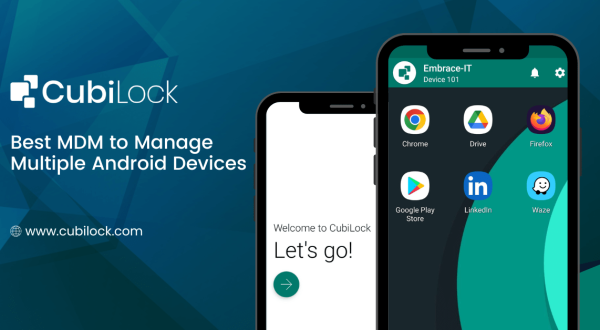Top Productivity Tools and EMM Solutions for 2024
- December 15, 2023

Productivity is what enterprises look for, and 75% of people say their smartphones make them more productive. enterprises are constantly seeking ways to enhance productivity, streamline operations, and foster collaboration among their teams. The rapid advancements in technology have given rise to a plethora of productivity tools designed to meet the evolving needs of businesses. As we enter 2024, enterprises must stay abreast of the latest innovations to maintain a competitive edge. In this article, we will explore the five best productivity tools for enterprises in 2024, along with the integration of Enterprise Mobility Management (EMM) solutions.
Microsoft 365:
Microsoft 365 continues to be a powerhouse in the productivity tools landscape. Combining familiar applications like Word, Excel, and PowerPoint with cloud services such as OneDrive and Teams, Microsoft 365 offers a comprehensive suite for collaboration and document management. With real-time co-authoring, intelligent insights, and robust security features, Microsoft 365 empowers enterprises to enhance communication, streamline workflows, and boost overall productivity. The integration of Microsoft Teams, a unified communication and collaboration platform, has become indispensable for remote and hybrid work environments.
Slack:
Slack has revolutionized team communication, providing a centralized platform for real-time messaging, file sharing, and collaboration. Its intuitive interface and diverse integrations make it a go-to tool for enterprises looking to streamline communication and enhance team collaboration. Slack channels facilitate organized conversations, while features like file sharing, direct messaging, and integration with third-party applications contribute to a seamless workflow. As remote work becomes increasingly prevalent, Slack’s ability to keep teams connected and informed makes it a valuable asset for enterprise productivity.
Asana:
Project management is at the core of successful enterprise operations, and Asana stands out as a top-tier solution in this domain. Asana allows teams to organize and track their work in a visually intuitive manner, providing features such as task assignments, due dates, and project timelines. The platform’s flexibility caters to various project management methodologies, from Agile to Waterfall. Asana’s ability to centralize project-related communication, track progress, and facilitate collaboration ensures that enterprises can efficiently manage their projects, resulting in improved productivity and project outcomes.
Salesforce:
For enterprises focused on customer relationship management (CRM) and sales, Salesforce remains an indispensable tool. The platform offers a comprehensive suite of applications to manage customer interactions, sales leads, and marketing campaigns. Salesforce’s cloud-based infrastructure ensures accessibility from anywhere, fostering collaboration among sales and marketing teams. With features like automation, analytics, and customizable dashboards, enterprises can streamline their sales processes, optimize customer engagement, and make data-driven decisions, ultimately boosting overall productivity.
Zoom:
As the landscape of work shifts towards remote and hybrid models, effective communication through video conferencing tools has become paramount. Zoom has emerged as a leader in this space, providing a reliable and user-friendly platform for virtual meetings, webinars, and collaborative sessions. With features like screen sharing, breakout rooms, and webinar hosting capabilities, Zoom facilitates seamless communication and collaboration across geographically dispersed teams. Its integration with calendar apps and third-party tools enhances its versatility, making it an essential productivity tool for enterprises in 2024.
Why Enterprise Mobility Management (EMM) Solution?
In addition to individual productivity tools, the integration of an EMM solution is crucial for enterprises managing a mobile workforce. EMM solutions are designed to secure, monitor, and manage mobile devices, applications, and content within an organization.
Leveraging EMM with CubiLock
CubiLock is a comprehensive EMM solution that combines unified management of devices, identity management, and mobile application management. It allows enterprises to securely manage a diverse range of devices, including smartphones, tablets, and laptops, from a centralized console. The platform enables the enforcement of security policies, remote device configuration, and the distribution of applications, ensuring a secure and productive mobile work environment.
Key features of CubiLock include:
- Unified Device Management: CubiLock provides a unified approach to managing devices, allowing enterprises to streamline the configuration and security of devices across various platforms.
- Identity Management: The platform offers robust identity and access management capabilities, ensuring that only authorized users can access sensitive enterprise data and applications.
- Mobile Application Management (MAM): CubiLock enables enterprises to control and secure mobile applications, including the ability to manage app distribution, updates, and access permissions.
- Adaptive Management: CubiLock adapts to the changing security landscape by employing adaptive management policies that dynamically adjust based on user behavior, device status, and location of the devices.
As enterprises navigate the dynamic landscape of business operations in 2024, the right productivity tools and EMM solutions can significantly impact efficiency, collaboration, and overall success. Microsoft 365, Slack, Asana, Salesforce, and Zoom continue to lead the way in enhancing productivity across various aspects of enterprise operations. Meanwhile, the integration of an EMM solution like CubiLock is essential for managing the increasing prevalence of mobile devices in the workplace. By leveraging these tools and solutions, enterprises can stay agile, competitive, and well-equipped for the challenges and opportunities that lie ahead.

Device Security Analyst, loves testing devices that are used for dedicated purposes.







